Auckland International Campus: Zero Carbon Bill Partnership Analysis
VerifiedAdded on 2022/08/11
|17
|5384
|18
Report
AI Summary
This report provides a comprehensive analysis of New Zealand's Zero Carbon Bill, examining its objectives, policies, and the strategies employed to achieve a zero-carbon future. The analysis delves into the bill's framework, including the setting of emission reduction targets, the strengthening of policies to encourage corporate sustainability, and the fostering of partnerships with local communities, particularly indigenous groups like iwi, hapu, and Māori researchers. The report also explores how the bill aims to create job opportunities and develop adaptive systems within corporations to enhance employability. Furthermore, it investigates the factors contributing to sustainability disequilibrium and proposes solutions to enhance partnerships and ensure the successful implementation of the Zero Carbon Bill. The report underscores the importance of community involvement, particularly in reducing plastic usage, conserving energy, and adopting sustainable travel habits, to achieve the bill's ambitious goals. The report also discusses the challenges and opportunities associated with aligning New Zealand's climate change policies with international agreements like the Paris Agreement. The report highlights the importance of education, innovation, and government support in achieving a carbon-free environment. The report concludes by emphasizing the need for a holistic approach that incorporates community engagement, technological advancements, and policy changes to ensure a sustainable future for New Zealand.

Running head: PARTNERSHIP FOR ZERO CARBON BILL
PARTNERSHIP FOR ZERO CARBON BILL
Name of the student:
Name of the university:
Author Note
PARTNERSHIP FOR ZERO CARBON BILL
Name of the student:
Name of the university:
Author Note
Paraphrase This Document
Need a fresh take? Get an instant paraphrase of this document with our AI Paraphraser
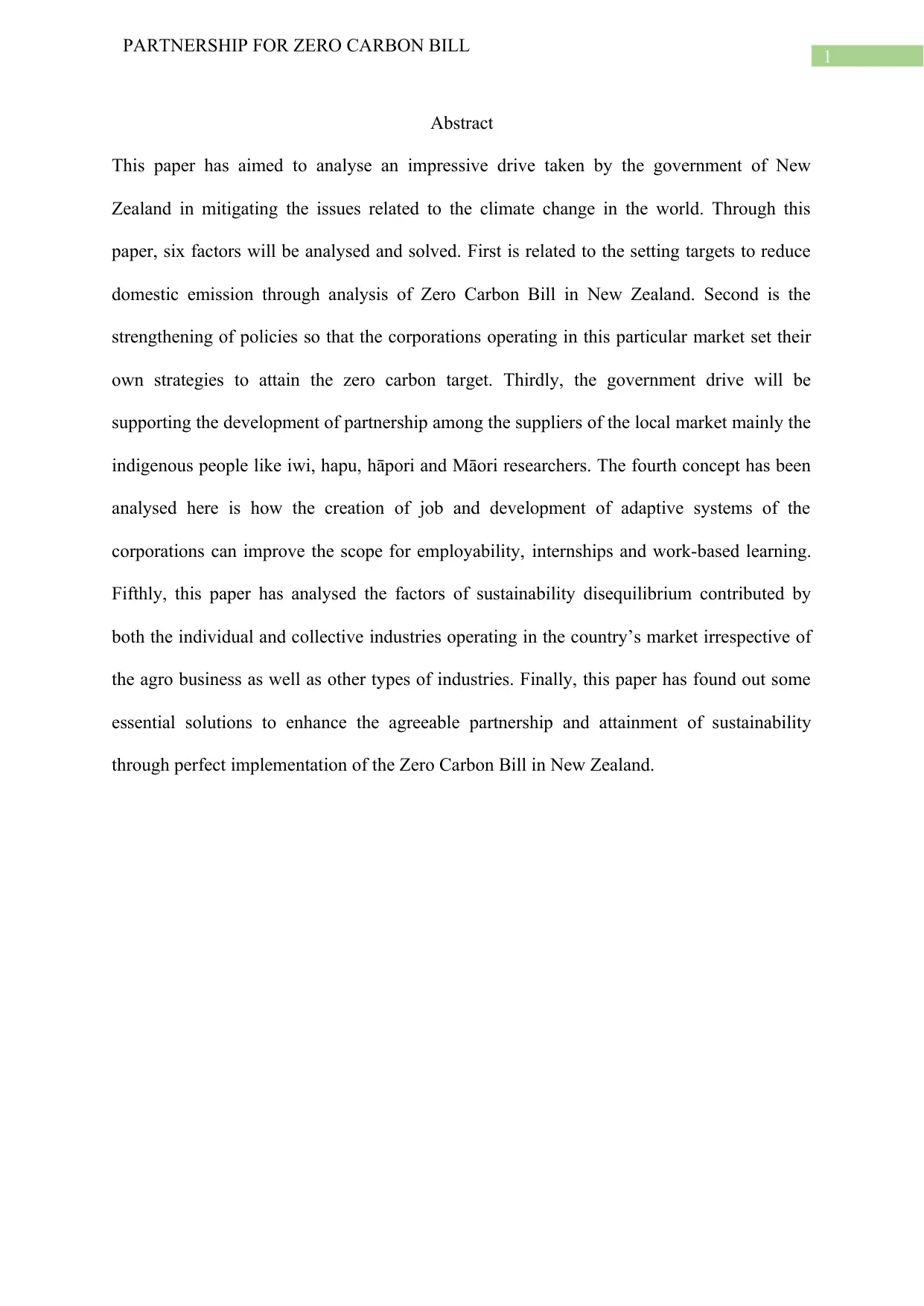
1
PARTNERSHIP FOR ZERO CARBON BILL
Abstract
This paper has aimed to analyse an impressive drive taken by the government of New
Zealand in mitigating the issues related to the climate change in the world. Through this
paper, six factors will be analysed and solved. First is related to the setting targets to reduce
domestic emission through analysis of Zero Carbon Bill in New Zealand. Second is the
strengthening of policies so that the corporations operating in this particular market set their
own strategies to attain the zero carbon target. Thirdly, the government drive will be
supporting the development of partnership among the suppliers of the local market mainly the
indigenous people like iwi, hapu, hāpori and Māori researchers. The fourth concept has been
analysed here is how the creation of job and development of adaptive systems of the
corporations can improve the scope for employability, internships and work-based learning.
Fifthly, this paper has analysed the factors of sustainability disequilibrium contributed by
both the individual and collective industries operating in the country’s market irrespective of
the agro business as well as other types of industries. Finally, this paper has found out some
essential solutions to enhance the agreeable partnership and attainment of sustainability
through perfect implementation of the Zero Carbon Bill in New Zealand.
PARTNERSHIP FOR ZERO CARBON BILL
Abstract
This paper has aimed to analyse an impressive drive taken by the government of New
Zealand in mitigating the issues related to the climate change in the world. Through this
paper, six factors will be analysed and solved. First is related to the setting targets to reduce
domestic emission through analysis of Zero Carbon Bill in New Zealand. Second is the
strengthening of policies so that the corporations operating in this particular market set their
own strategies to attain the zero carbon target. Thirdly, the government drive will be
supporting the development of partnership among the suppliers of the local market mainly the
indigenous people like iwi, hapu, hāpori and Māori researchers. The fourth concept has been
analysed here is how the creation of job and development of adaptive systems of the
corporations can improve the scope for employability, internships and work-based learning.
Fifthly, this paper has analysed the factors of sustainability disequilibrium contributed by
both the individual and collective industries operating in the country’s market irrespective of
the agro business as well as other types of industries. Finally, this paper has found out some
essential solutions to enhance the agreeable partnership and attainment of sustainability
through perfect implementation of the Zero Carbon Bill in New Zealand.
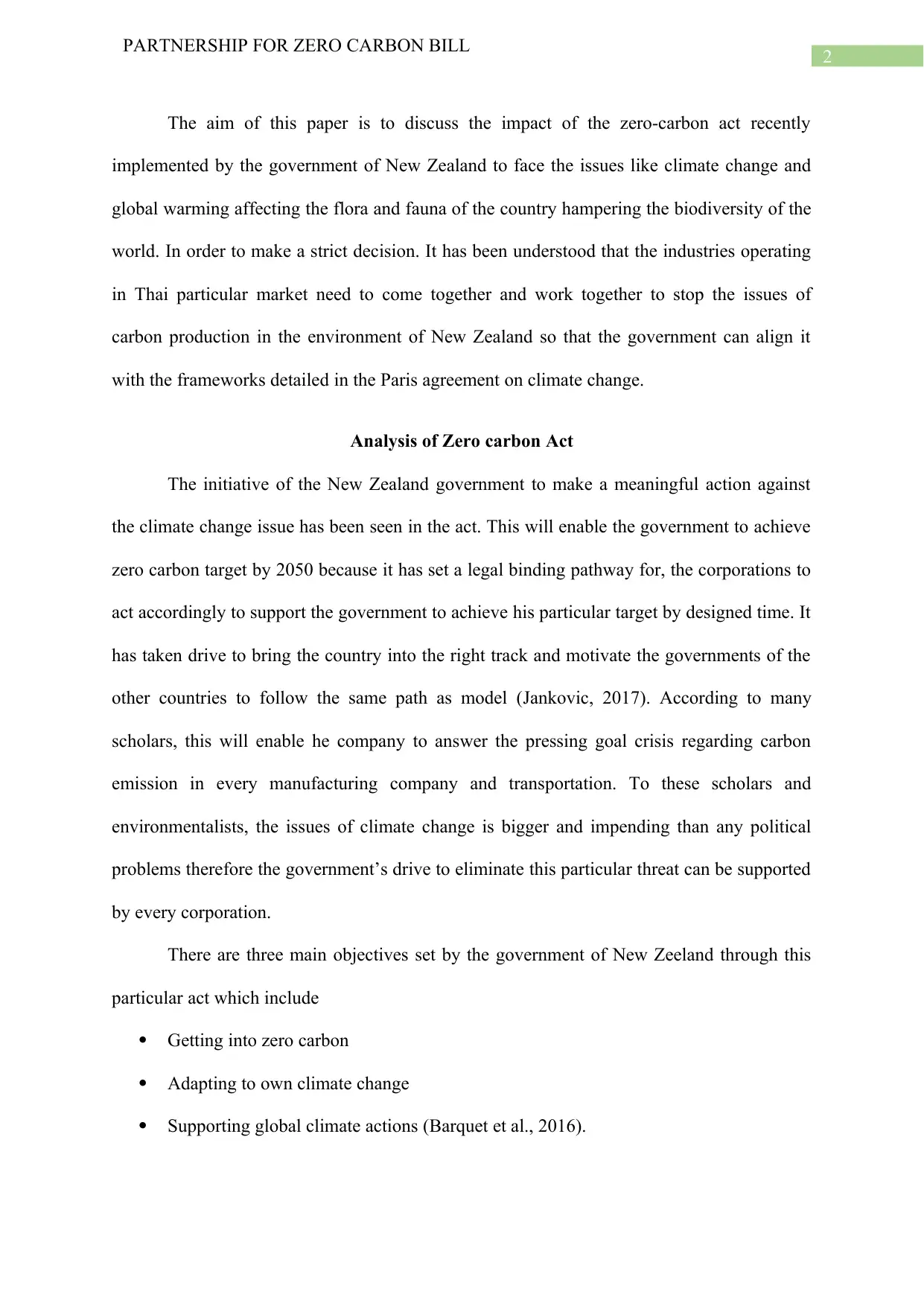
2
PARTNERSHIP FOR ZERO CARBON BILL
The aim of this paper is to discuss the impact of the zero-carbon act recently
implemented by the government of New Zealand to face the issues like climate change and
global warming affecting the flora and fauna of the country hampering the biodiversity of the
world. In order to make a strict decision. It has been understood that the industries operating
in Thai particular market need to come together and work together to stop the issues of
carbon production in the environment of New Zealand so that the government can align it
with the frameworks detailed in the Paris agreement on climate change.
Analysis of Zero carbon Act
The initiative of the New Zealand government to make a meaningful action against
the climate change issue has been seen in the act. This will enable the government to achieve
zero carbon target by 2050 because it has set a legal binding pathway for, the corporations to
act accordingly to support the government to achieve his particular target by designed time. It
has taken drive to bring the country into the right track and motivate the governments of the
other countries to follow the same path as model (Jankovic, 2017). According to many
scholars, this will enable he company to answer the pressing goal crisis regarding carbon
emission in every manufacturing company and transportation. To these scholars and
environmentalists, the issues of climate change is bigger and impending than any political
problems therefore the government’s drive to eliminate this particular threat can be supported
by every corporation.
There are three main objectives set by the government of New Zeeland through this
particular act which include
Getting into zero carbon
Adapting to own climate change
Supporting global climate actions (Barquet et al., 2016).
PARTNERSHIP FOR ZERO CARBON BILL
The aim of this paper is to discuss the impact of the zero-carbon act recently
implemented by the government of New Zealand to face the issues like climate change and
global warming affecting the flora and fauna of the country hampering the biodiversity of the
world. In order to make a strict decision. It has been understood that the industries operating
in Thai particular market need to come together and work together to stop the issues of
carbon production in the environment of New Zealand so that the government can align it
with the frameworks detailed in the Paris agreement on climate change.
Analysis of Zero carbon Act
The initiative of the New Zealand government to make a meaningful action against
the climate change issue has been seen in the act. This will enable the government to achieve
zero carbon target by 2050 because it has set a legal binding pathway for, the corporations to
act accordingly to support the government to achieve his particular target by designed time. It
has taken drive to bring the country into the right track and motivate the governments of the
other countries to follow the same path as model (Jankovic, 2017). According to many
scholars, this will enable he company to answer the pressing goal crisis regarding carbon
emission in every manufacturing company and transportation. To these scholars and
environmentalists, the issues of climate change is bigger and impending than any political
problems therefore the government’s drive to eliminate this particular threat can be supported
by every corporation.
There are three main objectives set by the government of New Zeeland through this
particular act which include
Getting into zero carbon
Adapting to own climate change
Supporting global climate actions (Barquet et al., 2016).
⊘ This is a preview!⊘
Do you want full access?
Subscribe today to unlock all pages.

Trusted by 1+ million students worldwide
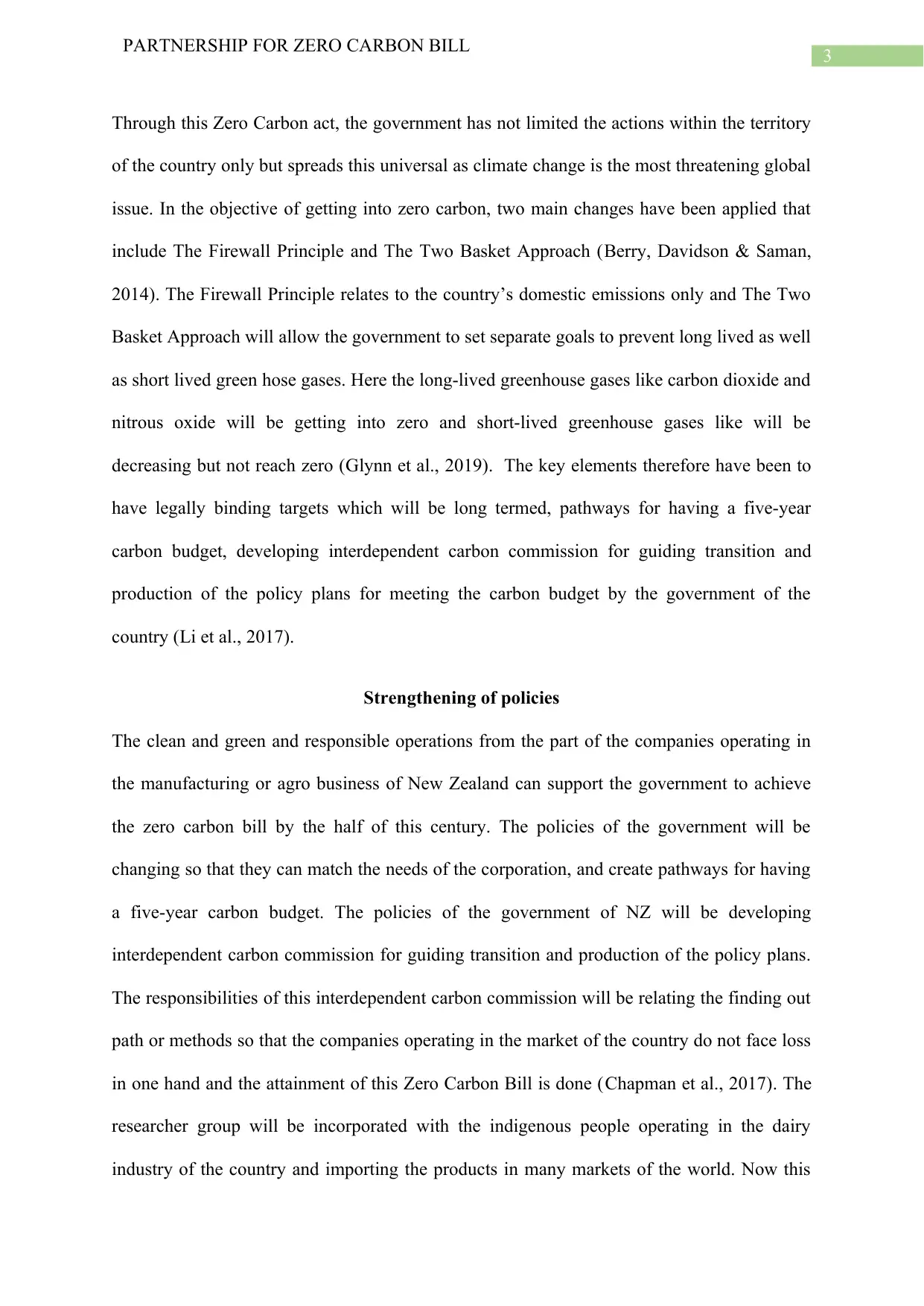
3
PARTNERSHIP FOR ZERO CARBON BILL
Through this Zero Carbon act, the government has not limited the actions within the territory
of the country only but spreads this universal as climate change is the most threatening global
issue. In the objective of getting into zero carbon, two main changes have been applied that
include The Firewall Principle and The Two Basket Approach (Berry, Davidson & Saman,
2014). The Firewall Principle relates to the country’s domestic emissions only and The Two
Basket Approach will allow the government to set separate goals to prevent long lived as well
as short lived green hose gases. Here the long-lived greenhouse gases like carbon dioxide and
nitrous oxide will be getting into zero and short-lived greenhouse gases like will be
decreasing but not reach zero (Glynn et al., 2019). The key elements therefore have been to
have legally binding targets which will be long termed, pathways for having a five-year
carbon budget, developing interdependent carbon commission for guiding transition and
production of the policy plans for meeting the carbon budget by the government of the
country (Li et al., 2017).
Strengthening of policies
The clean and green and responsible operations from the part of the companies operating in
the manufacturing or agro business of New Zealand can support the government to achieve
the zero carbon bill by the half of this century. The policies of the government will be
changing so that they can match the needs of the corporation, and create pathways for having
a five-year carbon budget. The policies of the government of NZ will be developing
interdependent carbon commission for guiding transition and production of the policy plans.
The responsibilities of this interdependent carbon commission will be relating the finding out
path or methods so that the companies operating in the market of the country do not face loss
in one hand and the attainment of this Zero Carbon Bill is done (Chapman et al., 2017). The
researcher group will be incorporated with the indigenous people operating in the dairy
industry of the country and importing the products in many markets of the world. Now this
PARTNERSHIP FOR ZERO CARBON BILL
Through this Zero Carbon act, the government has not limited the actions within the territory
of the country only but spreads this universal as climate change is the most threatening global
issue. In the objective of getting into zero carbon, two main changes have been applied that
include The Firewall Principle and The Two Basket Approach (Berry, Davidson & Saman,
2014). The Firewall Principle relates to the country’s domestic emissions only and The Two
Basket Approach will allow the government to set separate goals to prevent long lived as well
as short lived green hose gases. Here the long-lived greenhouse gases like carbon dioxide and
nitrous oxide will be getting into zero and short-lived greenhouse gases like will be
decreasing but not reach zero (Glynn et al., 2019). The key elements therefore have been to
have legally binding targets which will be long termed, pathways for having a five-year
carbon budget, developing interdependent carbon commission for guiding transition and
production of the policy plans for meeting the carbon budget by the government of the
country (Li et al., 2017).
Strengthening of policies
The clean and green and responsible operations from the part of the companies operating in
the manufacturing or agro business of New Zealand can support the government to achieve
the zero carbon bill by the half of this century. The policies of the government will be
changing so that they can match the needs of the corporation, and create pathways for having
a five-year carbon budget. The policies of the government of NZ will be developing
interdependent carbon commission for guiding transition and production of the policy plans.
The responsibilities of this interdependent carbon commission will be relating the finding out
path or methods so that the companies operating in the market of the country do not face loss
in one hand and the attainment of this Zero Carbon Bill is done (Chapman et al., 2017). The
researcher group will be incorporated with the indigenous people operating in the dairy
industry of the country and importing the products in many markets of the world. Now this
Paraphrase This Document
Need a fresh take? Get an instant paraphrase of this document with our AI Paraphraser
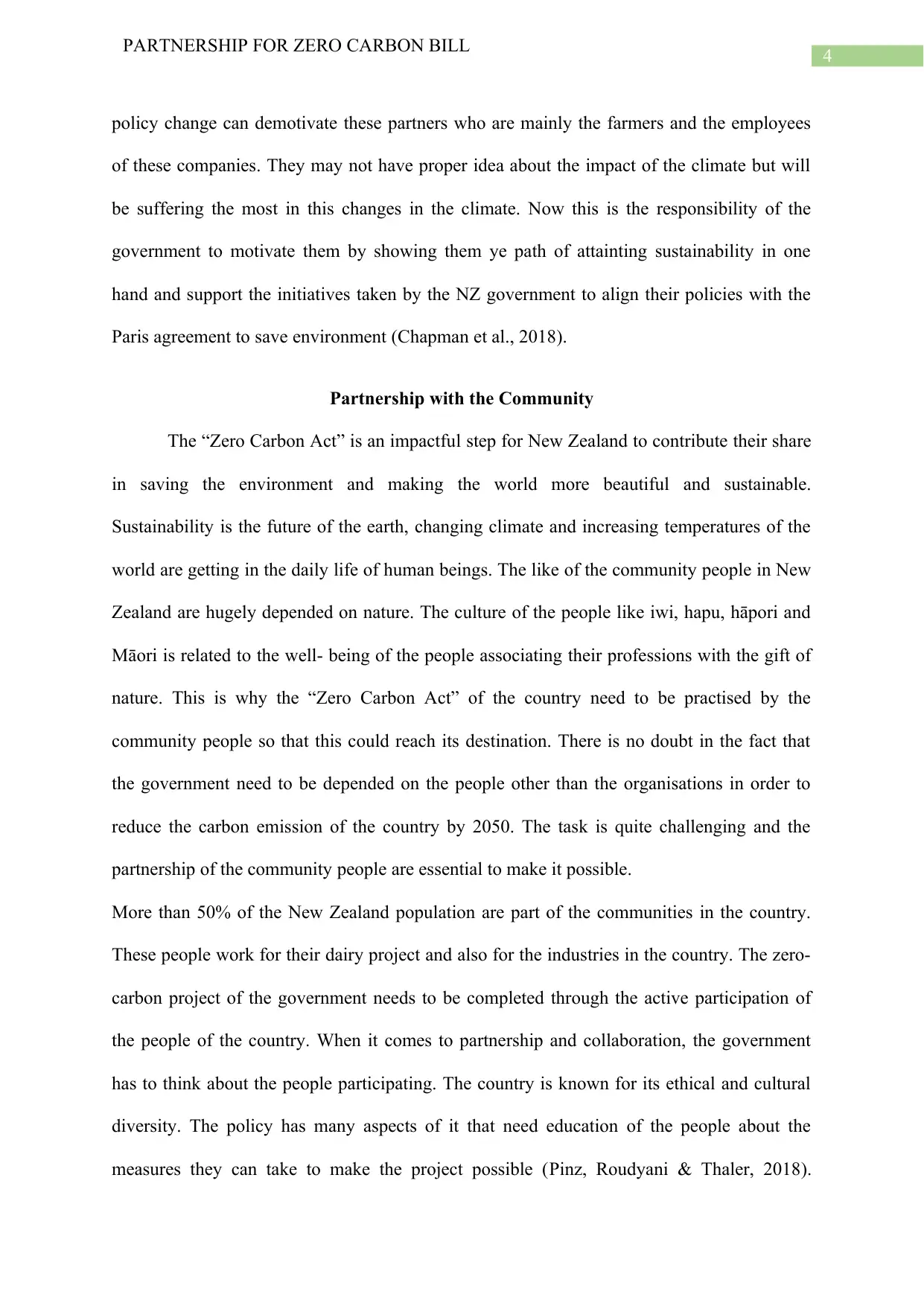
4
PARTNERSHIP FOR ZERO CARBON BILL
policy change can demotivate these partners who are mainly the farmers and the employees
of these companies. They may not have proper idea about the impact of the climate but will
be suffering the most in this changes in the climate. Now this is the responsibility of the
government to motivate them by showing them ye path of attainting sustainability in one
hand and support the initiatives taken by the NZ government to align their policies with the
Paris agreement to save environment (Chapman et al., 2018).
Partnership with the Community
The “Zero Carbon Act” is an impactful step for New Zealand to contribute their share
in saving the environment and making the world more beautiful and sustainable.
Sustainability is the future of the earth, changing climate and increasing temperatures of the
world are getting in the daily life of human beings. The like of the community people in New
Zealand are hugely depended on nature. The culture of the people like iwi, hapu, hāpori and
Māori is related to the well- being of the people associating their professions with the gift of
nature. This is why the “Zero Carbon Act” of the country need to be practised by the
community people so that this could reach its destination. There is no doubt in the fact that
the government need to be depended on the people other than the organisations in order to
reduce the carbon emission of the country by 2050. The task is quite challenging and the
partnership of the community people are essential to make it possible.
More than 50% of the New Zealand population are part of the communities in the country.
These people work for their dairy project and also for the industries in the country. The zero-
carbon project of the government needs to be completed through the active participation of
the people of the country. When it comes to partnership and collaboration, the government
has to think about the people participating. The country is known for its ethical and cultural
diversity. The policy has many aspects of it that need education of the people about the
measures they can take to make the project possible (Pinz, Roudyani & Thaler, 2018).
PARTNERSHIP FOR ZERO CARBON BILL
policy change can demotivate these partners who are mainly the farmers and the employees
of these companies. They may not have proper idea about the impact of the climate but will
be suffering the most in this changes in the climate. Now this is the responsibility of the
government to motivate them by showing them ye path of attainting sustainability in one
hand and support the initiatives taken by the NZ government to align their policies with the
Paris agreement to save environment (Chapman et al., 2018).
Partnership with the Community
The “Zero Carbon Act” is an impactful step for New Zealand to contribute their share
in saving the environment and making the world more beautiful and sustainable.
Sustainability is the future of the earth, changing climate and increasing temperatures of the
world are getting in the daily life of human beings. The like of the community people in New
Zealand are hugely depended on nature. The culture of the people like iwi, hapu, hāpori and
Māori is related to the well- being of the people associating their professions with the gift of
nature. This is why the “Zero Carbon Act” of the country need to be practised by the
community people so that this could reach its destination. There is no doubt in the fact that
the government need to be depended on the people other than the organisations in order to
reduce the carbon emission of the country by 2050. The task is quite challenging and the
partnership of the community people are essential to make it possible.
More than 50% of the New Zealand population are part of the communities in the country.
These people work for their dairy project and also for the industries in the country. The zero-
carbon project of the government needs to be completed through the active participation of
the people of the country. When it comes to partnership and collaboration, the government
has to think about the people participating. The country is known for its ethical and cultural
diversity. The policy has many aspects of it that need education of the people about the
measures they can take to make the project possible (Pinz, Roudyani & Thaler, 2018).
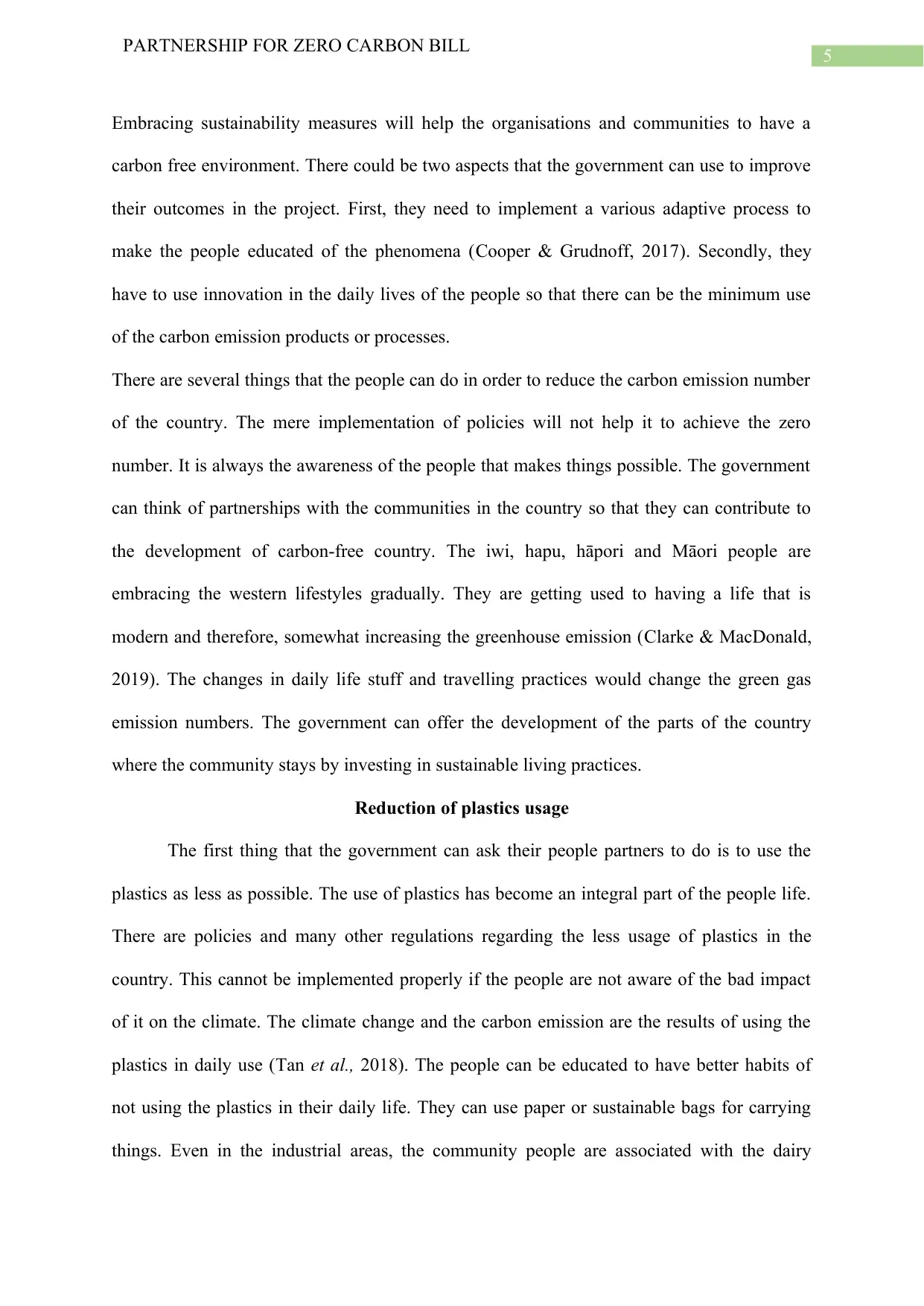
5
PARTNERSHIP FOR ZERO CARBON BILL
Embracing sustainability measures will help the organisations and communities to have a
carbon free environment. There could be two aspects that the government can use to improve
their outcomes in the project. First, they need to implement a various adaptive process to
make the people educated of the phenomena (Cooper & Grudnoff, 2017). Secondly, they
have to use innovation in the daily lives of the people so that there can be the minimum use
of the carbon emission products or processes.
There are several things that the people can do in order to reduce the carbon emission number
of the country. The mere implementation of policies will not help it to achieve the zero
number. It is always the awareness of the people that makes things possible. The government
can think of partnerships with the communities in the country so that they can contribute to
the development of carbon-free country. The iwi, hapu, hāpori and Māori people are
embracing the western lifestyles gradually. They are getting used to having a life that is
modern and therefore, somewhat increasing the greenhouse emission (Clarke & MacDonald,
2019). The changes in daily life stuff and travelling practices would change the green gas
emission numbers. The government can offer the development of the parts of the country
where the community stays by investing in sustainable living practices.
Reduction of plastics usage
The first thing that the government can ask their people partners to do is to use the
plastics as less as possible. The use of plastics has become an integral part of the people life.
There are policies and many other regulations regarding the less usage of plastics in the
country. This cannot be implemented properly if the people are not aware of the bad impact
of it on the climate. The climate change and the carbon emission are the results of using the
plastics in daily use (Tan et al., 2018). The people can be educated to have better habits of
not using the plastics in their daily life. They can use paper or sustainable bags for carrying
things. Even in the industrial areas, the community people are associated with the dairy
PARTNERSHIP FOR ZERO CARBON BILL
Embracing sustainability measures will help the organisations and communities to have a
carbon free environment. There could be two aspects that the government can use to improve
their outcomes in the project. First, they need to implement a various adaptive process to
make the people educated of the phenomena (Cooper & Grudnoff, 2017). Secondly, they
have to use innovation in the daily lives of the people so that there can be the minimum use
of the carbon emission products or processes.
There are several things that the people can do in order to reduce the carbon emission number
of the country. The mere implementation of policies will not help it to achieve the zero
number. It is always the awareness of the people that makes things possible. The government
can think of partnerships with the communities in the country so that they can contribute to
the development of carbon-free country. The iwi, hapu, hāpori and Māori people are
embracing the western lifestyles gradually. They are getting used to having a life that is
modern and therefore, somewhat increasing the greenhouse emission (Clarke & MacDonald,
2019). The changes in daily life stuff and travelling practices would change the green gas
emission numbers. The government can offer the development of the parts of the country
where the community stays by investing in sustainable living practices.
Reduction of plastics usage
The first thing that the government can ask their people partners to do is to use the
plastics as less as possible. The use of plastics has become an integral part of the people life.
There are policies and many other regulations regarding the less usage of plastics in the
country. This cannot be implemented properly if the people are not aware of the bad impact
of it on the climate. The climate change and the carbon emission are the results of using the
plastics in daily use (Tan et al., 2018). The people can be educated to have better habits of
not using the plastics in their daily life. They can use paper or sustainable bags for carrying
things. Even in the industrial areas, the community people are associated with the dairy
⊘ This is a preview!⊘
Do you want full access?
Subscribe today to unlock all pages.

Trusted by 1+ million students worldwide
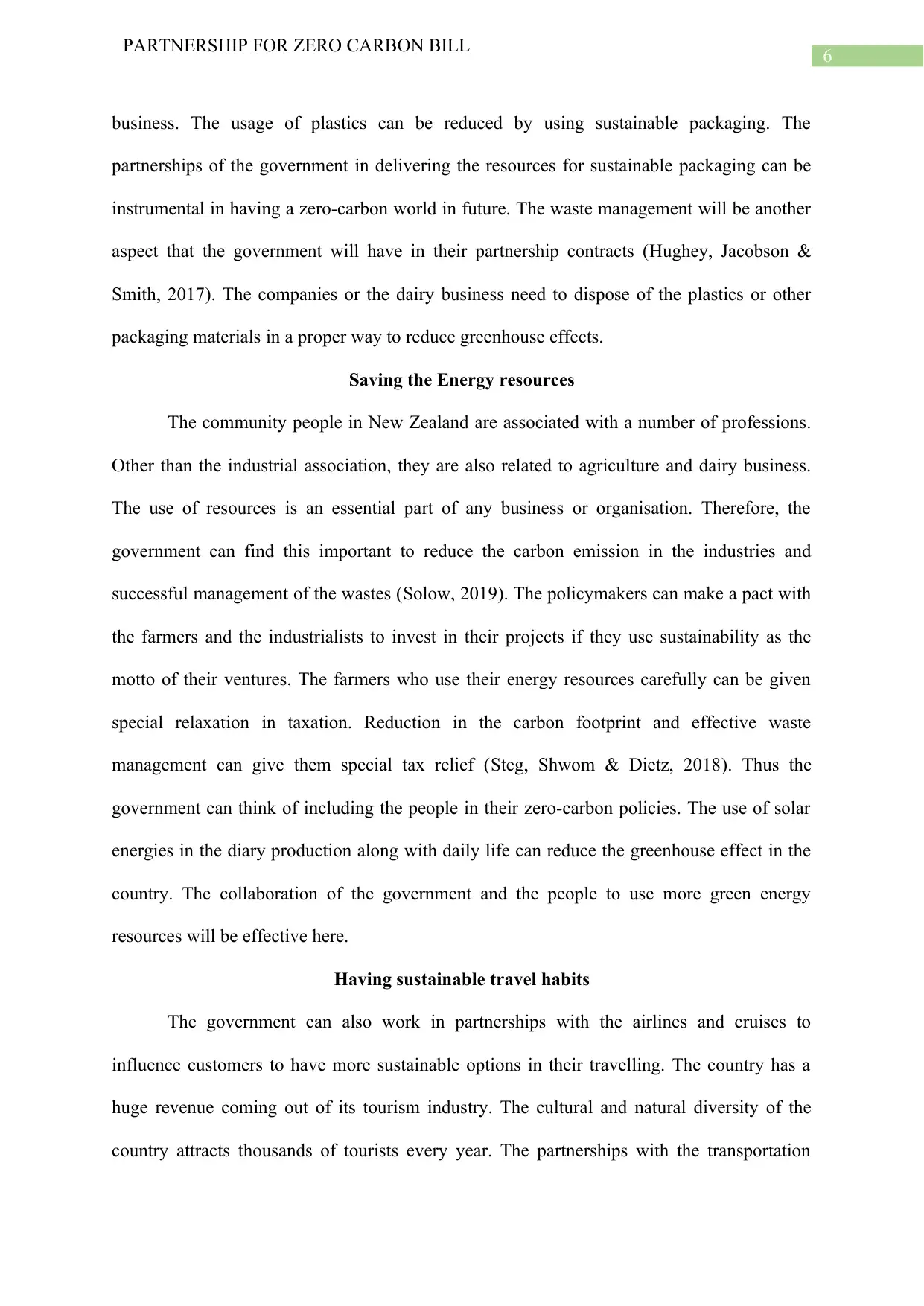
6
PARTNERSHIP FOR ZERO CARBON BILL
business. The usage of plastics can be reduced by using sustainable packaging. The
partnerships of the government in delivering the resources for sustainable packaging can be
instrumental in having a zero-carbon world in future. The waste management will be another
aspect that the government will have in their partnership contracts (Hughey, Jacobson &
Smith, 2017). The companies or the dairy business need to dispose of the plastics or other
packaging materials in a proper way to reduce greenhouse effects.
Saving the Energy resources
The community people in New Zealand are associated with a number of professions.
Other than the industrial association, they are also related to agriculture and dairy business.
The use of resources is an essential part of any business or organisation. Therefore, the
government can find this important to reduce the carbon emission in the industries and
successful management of the wastes (Solow, 2019). The policymakers can make a pact with
the farmers and the industrialists to invest in their projects if they use sustainability as the
motto of their ventures. The farmers who use their energy resources carefully can be given
special relaxation in taxation. Reduction in the carbon footprint and effective waste
management can give them special tax relief (Steg, Shwom & Dietz, 2018). Thus the
government can think of including the people in their zero-carbon policies. The use of solar
energies in the diary production along with daily life can reduce the greenhouse effect in the
country. The collaboration of the government and the people to use more green energy
resources will be effective here.
Having sustainable travel habits
The government can also work in partnerships with the airlines and cruises to
influence customers to have more sustainable options in their travelling. The country has a
huge revenue coming out of its tourism industry. The cultural and natural diversity of the
country attracts thousands of tourists every year. The partnerships with the transportation
PARTNERSHIP FOR ZERO CARBON BILL
business. The usage of plastics can be reduced by using sustainable packaging. The
partnerships of the government in delivering the resources for sustainable packaging can be
instrumental in having a zero-carbon world in future. The waste management will be another
aspect that the government will have in their partnership contracts (Hughey, Jacobson &
Smith, 2017). The companies or the dairy business need to dispose of the plastics or other
packaging materials in a proper way to reduce greenhouse effects.
Saving the Energy resources
The community people in New Zealand are associated with a number of professions.
Other than the industrial association, they are also related to agriculture and dairy business.
The use of resources is an essential part of any business or organisation. Therefore, the
government can find this important to reduce the carbon emission in the industries and
successful management of the wastes (Solow, 2019). The policymakers can make a pact with
the farmers and the industrialists to invest in their projects if they use sustainability as the
motto of their ventures. The farmers who use their energy resources carefully can be given
special relaxation in taxation. Reduction in the carbon footprint and effective waste
management can give them special tax relief (Steg, Shwom & Dietz, 2018). Thus the
government can think of including the people in their zero-carbon policies. The use of solar
energies in the diary production along with daily life can reduce the greenhouse effect in the
country. The collaboration of the government and the people to use more green energy
resources will be effective here.
Having sustainable travel habits
The government can also work in partnerships with the airlines and cruises to
influence customers to have more sustainable options in their travelling. The country has a
huge revenue coming out of its tourism industry. The cultural and natural diversity of the
country attracts thousands of tourists every year. The partnerships with the transportation
Paraphrase This Document
Need a fresh take? Get an instant paraphrase of this document with our AI Paraphraser
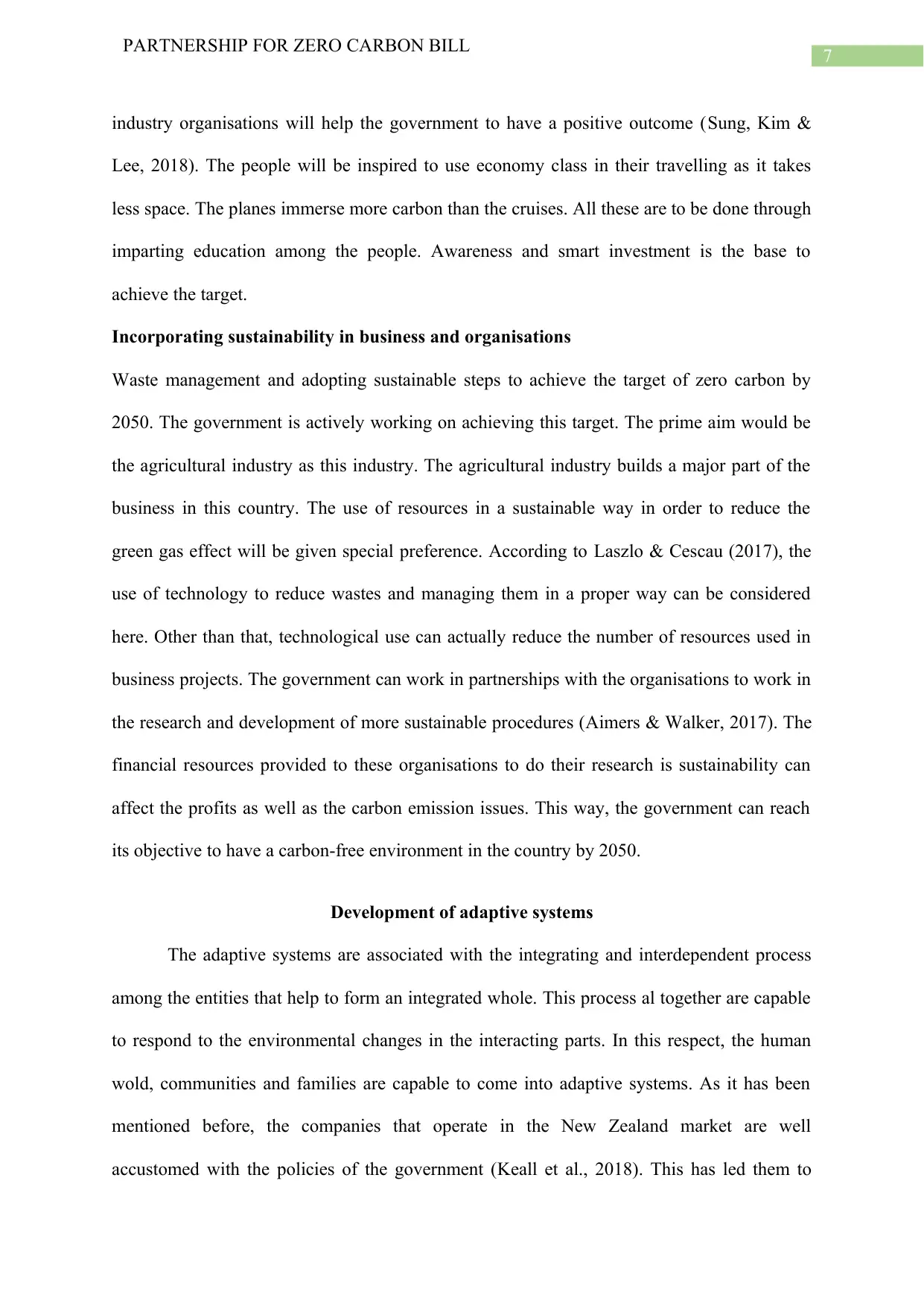
7
PARTNERSHIP FOR ZERO CARBON BILL
industry organisations will help the government to have a positive outcome (Sung, Kim &
Lee, 2018). The people will be inspired to use economy class in their travelling as it takes
less space. The planes immerse more carbon than the cruises. All these are to be done through
imparting education among the people. Awareness and smart investment is the base to
achieve the target.
Incorporating sustainability in business and organisations
Waste management and adopting sustainable steps to achieve the target of zero carbon by
2050. The government is actively working on achieving this target. The prime aim would be
the agricultural industry as this industry. The agricultural industry builds a major part of the
business in this country. The use of resources in a sustainable way in order to reduce the
green gas effect will be given special preference. According to Laszlo & Cescau (2017), the
use of technology to reduce wastes and managing them in a proper way can be considered
here. Other than that, technological use can actually reduce the number of resources used in
business projects. The government can work in partnerships with the organisations to work in
the research and development of more sustainable procedures (Aimers & Walker, 2017). The
financial resources provided to these organisations to do their research is sustainability can
affect the profits as well as the carbon emission issues. This way, the government can reach
its objective to have a carbon-free environment in the country by 2050.
Development of adaptive systems
The adaptive systems are associated with the integrating and interdependent process
among the entities that help to form an integrated whole. This process al together are capable
to respond to the environmental changes in the interacting parts. In this respect, the human
wold, communities and families are capable to come into adaptive systems. As it has been
mentioned before, the companies that operate in the New Zealand market are well
accustomed with the policies of the government (Keall et al., 2018). This has led them to
PARTNERSHIP FOR ZERO CARBON BILL
industry organisations will help the government to have a positive outcome (Sung, Kim &
Lee, 2018). The people will be inspired to use economy class in their travelling as it takes
less space. The planes immerse more carbon than the cruises. All these are to be done through
imparting education among the people. Awareness and smart investment is the base to
achieve the target.
Incorporating sustainability in business and organisations
Waste management and adopting sustainable steps to achieve the target of zero carbon by
2050. The government is actively working on achieving this target. The prime aim would be
the agricultural industry as this industry. The agricultural industry builds a major part of the
business in this country. The use of resources in a sustainable way in order to reduce the
green gas effect will be given special preference. According to Laszlo & Cescau (2017), the
use of technology to reduce wastes and managing them in a proper way can be considered
here. Other than that, technological use can actually reduce the number of resources used in
business projects. The government can work in partnerships with the organisations to work in
the research and development of more sustainable procedures (Aimers & Walker, 2017). The
financial resources provided to these organisations to do their research is sustainability can
affect the profits as well as the carbon emission issues. This way, the government can reach
its objective to have a carbon-free environment in the country by 2050.
Development of adaptive systems
The adaptive systems are associated with the integrating and interdependent process
among the entities that help to form an integrated whole. This process al together are capable
to respond to the environmental changes in the interacting parts. In this respect, the human
wold, communities and families are capable to come into adaptive systems. As it has been
mentioned before, the companies that operate in the New Zealand market are well
accustomed with the policies of the government (Keall et al., 2018). This has led them to
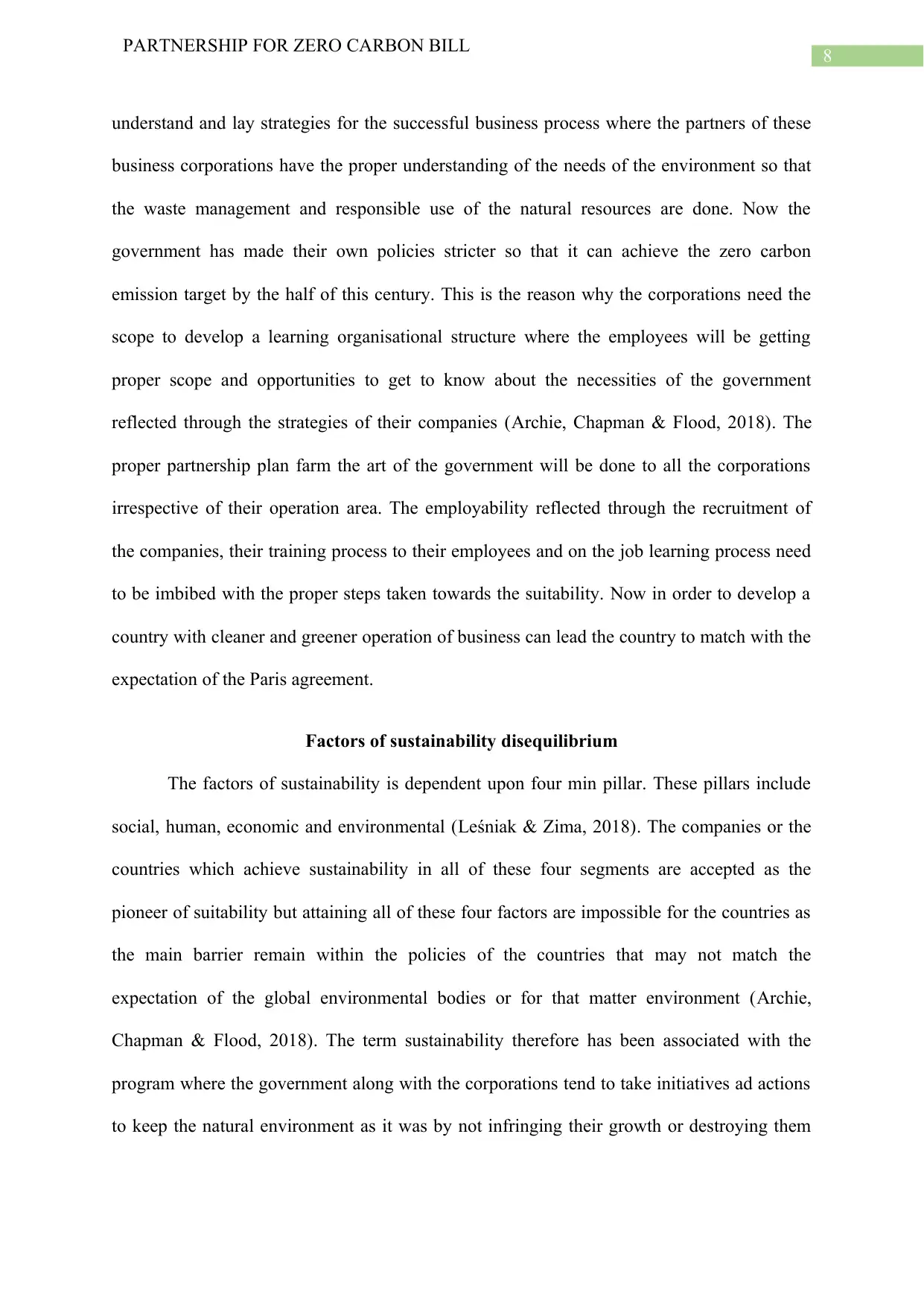
8
PARTNERSHIP FOR ZERO CARBON BILL
understand and lay strategies for the successful business process where the partners of these
business corporations have the proper understanding of the needs of the environment so that
the waste management and responsible use of the natural resources are done. Now the
government has made their own policies stricter so that it can achieve the zero carbon
emission target by the half of this century. This is the reason why the corporations need the
scope to develop a learning organisational structure where the employees will be getting
proper scope and opportunities to get to know about the necessities of the government
reflected through the strategies of their companies (Archie, Chapman & Flood, 2018). The
proper partnership plan farm the art of the government will be done to all the corporations
irrespective of their operation area. The employability reflected through the recruitment of
the companies, their training process to their employees and on the job learning process need
to be imbibed with the proper steps taken towards the suitability. Now in order to develop a
country with cleaner and greener operation of business can lead the country to match with the
expectation of the Paris agreement.
Factors of sustainability disequilibrium
The factors of sustainability is dependent upon four min pillar. These pillars include
social, human, economic and environmental (Leśniak & Zima, 2018). The companies or the
countries which achieve sustainability in all of these four segments are accepted as the
pioneer of suitability but attaining all of these four factors are impossible for the countries as
the main barrier remain within the policies of the countries that may not match the
expectation of the global environmental bodies or for that matter environment (Archie,
Chapman & Flood, 2018). The term sustainability therefore has been associated with the
program where the government along with the corporations tend to take initiatives ad actions
to keep the natural environment as it was by not infringing their growth or destroying them
PARTNERSHIP FOR ZERO CARBON BILL
understand and lay strategies for the successful business process where the partners of these
business corporations have the proper understanding of the needs of the environment so that
the waste management and responsible use of the natural resources are done. Now the
government has made their own policies stricter so that it can achieve the zero carbon
emission target by the half of this century. This is the reason why the corporations need the
scope to develop a learning organisational structure where the employees will be getting
proper scope and opportunities to get to know about the necessities of the government
reflected through the strategies of their companies (Archie, Chapman & Flood, 2018). The
proper partnership plan farm the art of the government will be done to all the corporations
irrespective of their operation area. The employability reflected through the recruitment of
the companies, their training process to their employees and on the job learning process need
to be imbibed with the proper steps taken towards the suitability. Now in order to develop a
country with cleaner and greener operation of business can lead the country to match with the
expectation of the Paris agreement.
Factors of sustainability disequilibrium
The factors of sustainability is dependent upon four min pillar. These pillars include
social, human, economic and environmental (Leśniak & Zima, 2018). The companies or the
countries which achieve sustainability in all of these four segments are accepted as the
pioneer of suitability but attaining all of these four factors are impossible for the countries as
the main barrier remain within the policies of the countries that may not match the
expectation of the global environmental bodies or for that matter environment (Archie,
Chapman & Flood, 2018). The term sustainability therefore has been associated with the
program where the government along with the corporations tend to take initiatives ad actions
to keep the natural environment as it was by not infringing their growth or destroying them
⊘ This is a preview!⊘
Do you want full access?
Subscribe today to unlock all pages.

Trusted by 1+ million students worldwide
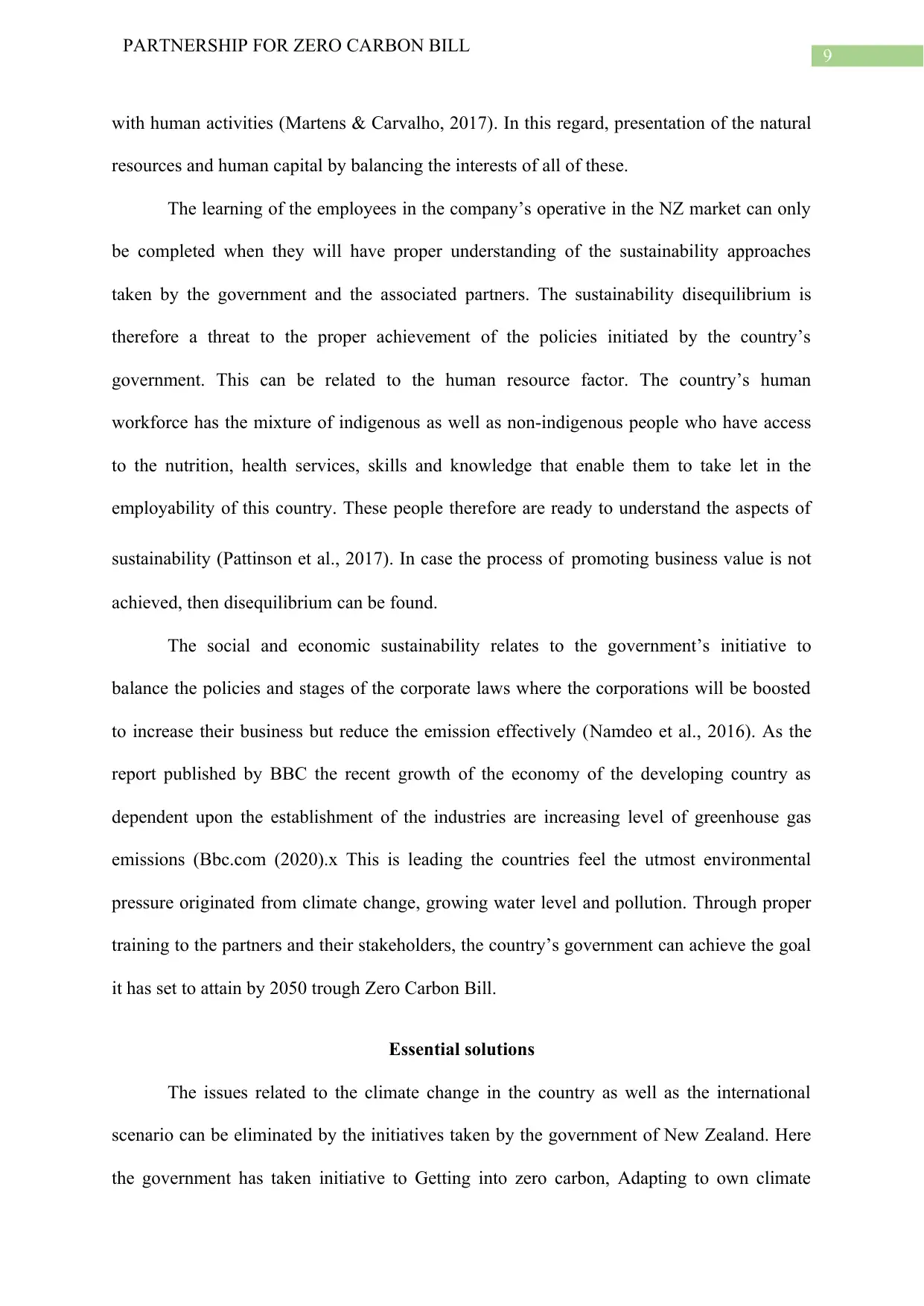
9
PARTNERSHIP FOR ZERO CARBON BILL
with human activities (Martens & Carvalho, 2017). In this regard, presentation of the natural
resources and human capital by balancing the interests of all of these.
The learning of the employees in the company’s operative in the NZ market can only
be completed when they will have proper understanding of the sustainability approaches
taken by the government and the associated partners. The sustainability disequilibrium is
therefore a threat to the proper achievement of the policies initiated by the country’s
government. This can be related to the human resource factor. The country’s human
workforce has the mixture of indigenous as well as non-indigenous people who have access
to the nutrition, health services, skills and knowledge that enable them to take let in the
employability of this country. These people therefore are ready to understand the aspects of
sustainability (Pattinson et al., 2017). In case the process of promoting business value is not
achieved, then disequilibrium can be found.
The social and economic sustainability relates to the government’s initiative to
balance the policies and stages of the corporate laws where the corporations will be boosted
to increase their business but reduce the emission effectively (Namdeo et al., 2016). As the
report published by BBC the recent growth of the economy of the developing country as
dependent upon the establishment of the industries are increasing level of greenhouse gas
emissions (Bbc.com (2020).x This is leading the countries feel the utmost environmental
pressure originated from climate change, growing water level and pollution. Through proper
training to the partners and their stakeholders, the country’s government can achieve the goal
it has set to attain by 2050 trough Zero Carbon Bill.
Essential solutions
The issues related to the climate change in the country as well as the international
scenario can be eliminated by the initiatives taken by the government of New Zealand. Here
the government has taken initiative to Getting into zero carbon, Adapting to own climate
PARTNERSHIP FOR ZERO CARBON BILL
with human activities (Martens & Carvalho, 2017). In this regard, presentation of the natural
resources and human capital by balancing the interests of all of these.
The learning of the employees in the company’s operative in the NZ market can only
be completed when they will have proper understanding of the sustainability approaches
taken by the government and the associated partners. The sustainability disequilibrium is
therefore a threat to the proper achievement of the policies initiated by the country’s
government. This can be related to the human resource factor. The country’s human
workforce has the mixture of indigenous as well as non-indigenous people who have access
to the nutrition, health services, skills and knowledge that enable them to take let in the
employability of this country. These people therefore are ready to understand the aspects of
sustainability (Pattinson et al., 2017). In case the process of promoting business value is not
achieved, then disequilibrium can be found.
The social and economic sustainability relates to the government’s initiative to
balance the policies and stages of the corporate laws where the corporations will be boosted
to increase their business but reduce the emission effectively (Namdeo et al., 2016). As the
report published by BBC the recent growth of the economy of the developing country as
dependent upon the establishment of the industries are increasing level of greenhouse gas
emissions (Bbc.com (2020).x This is leading the countries feel the utmost environmental
pressure originated from climate change, growing water level and pollution. Through proper
training to the partners and their stakeholders, the country’s government can achieve the goal
it has set to attain by 2050 trough Zero Carbon Bill.
Essential solutions
The issues related to the climate change in the country as well as the international
scenario can be eliminated by the initiatives taken by the government of New Zealand. Here
the government has taken initiative to Getting into zero carbon, Adapting to own climate
Paraphrase This Document
Need a fresh take? Get an instant paraphrase of this document with our AI Paraphraser
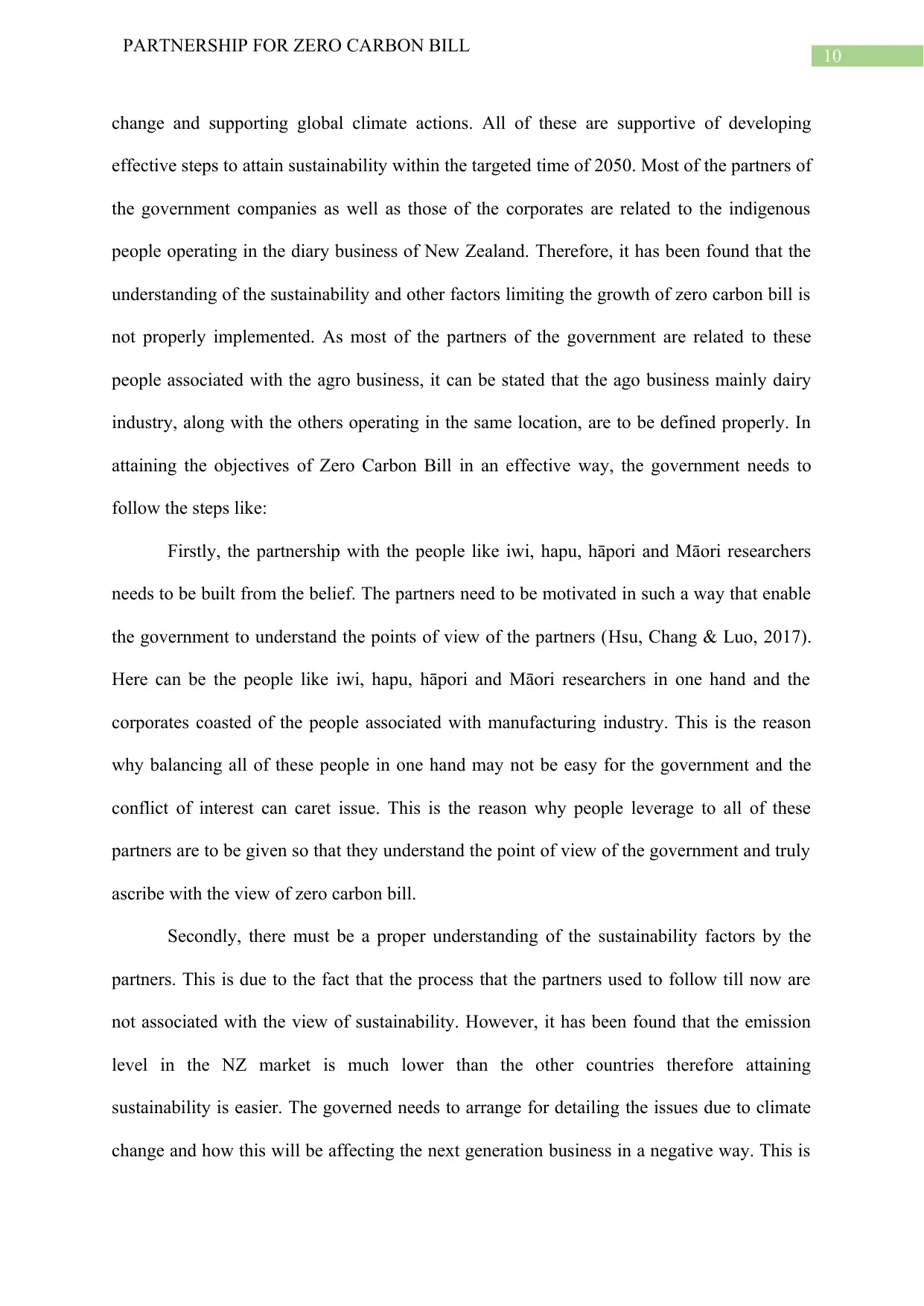
10
PARTNERSHIP FOR ZERO CARBON BILL
change and supporting global climate actions. All of these are supportive of developing
effective steps to attain sustainability within the targeted time of 2050. Most of the partners of
the government companies as well as those of the corporates are related to the indigenous
people operating in the diary business of New Zealand. Therefore, it has been found that the
understanding of the sustainability and other factors limiting the growth of zero carbon bill is
not properly implemented. As most of the partners of the government are related to these
people associated with the agro business, it can be stated that the ago business mainly dairy
industry, along with the others operating in the same location, are to be defined properly. In
attaining the objectives of Zero Carbon Bill in an effective way, the government needs to
follow the steps like:
Firstly, the partnership with the people like iwi, hapu, hāpori and Māori researchers
needs to be built from the belief. The partners need to be motivated in such a way that enable
the government to understand the points of view of the partners (Hsu, Chang & Luo, 2017).
Here can be the people like iwi, hapu, hāpori and Māori researchers in one hand and the
corporates coasted of the people associated with manufacturing industry. This is the reason
why balancing all of these people in one hand may not be easy for the government and the
conflict of interest can caret issue. This is the reason why people leverage to all of these
partners are to be given so that they understand the point of view of the government and truly
ascribe with the view of zero carbon bill.
Secondly, there must be a proper understanding of the sustainability factors by the
partners. This is due to the fact that the process that the partners used to follow till now are
not associated with the view of sustainability. However, it has been found that the emission
level in the NZ market is much lower than the other countries therefore attaining
sustainability is easier. The governed needs to arrange for detailing the issues due to climate
change and how this will be affecting the next generation business in a negative way. This is
PARTNERSHIP FOR ZERO CARBON BILL
change and supporting global climate actions. All of these are supportive of developing
effective steps to attain sustainability within the targeted time of 2050. Most of the partners of
the government companies as well as those of the corporates are related to the indigenous
people operating in the diary business of New Zealand. Therefore, it has been found that the
understanding of the sustainability and other factors limiting the growth of zero carbon bill is
not properly implemented. As most of the partners of the government are related to these
people associated with the agro business, it can be stated that the ago business mainly dairy
industry, along with the others operating in the same location, are to be defined properly. In
attaining the objectives of Zero Carbon Bill in an effective way, the government needs to
follow the steps like:
Firstly, the partnership with the people like iwi, hapu, hāpori and Māori researchers
needs to be built from the belief. The partners need to be motivated in such a way that enable
the government to understand the points of view of the partners (Hsu, Chang & Luo, 2017).
Here can be the people like iwi, hapu, hāpori and Māori researchers in one hand and the
corporates coasted of the people associated with manufacturing industry. This is the reason
why balancing all of these people in one hand may not be easy for the government and the
conflict of interest can caret issue. This is the reason why people leverage to all of these
partners are to be given so that they understand the point of view of the government and truly
ascribe with the view of zero carbon bill.
Secondly, there must be a proper understanding of the sustainability factors by the
partners. This is due to the fact that the process that the partners used to follow till now are
not associated with the view of sustainability. However, it has been found that the emission
level in the NZ market is much lower than the other countries therefore attaining
sustainability is easier. The governed needs to arrange for detailing the issues due to climate
change and how this will be affecting the next generation business in a negative way. This is
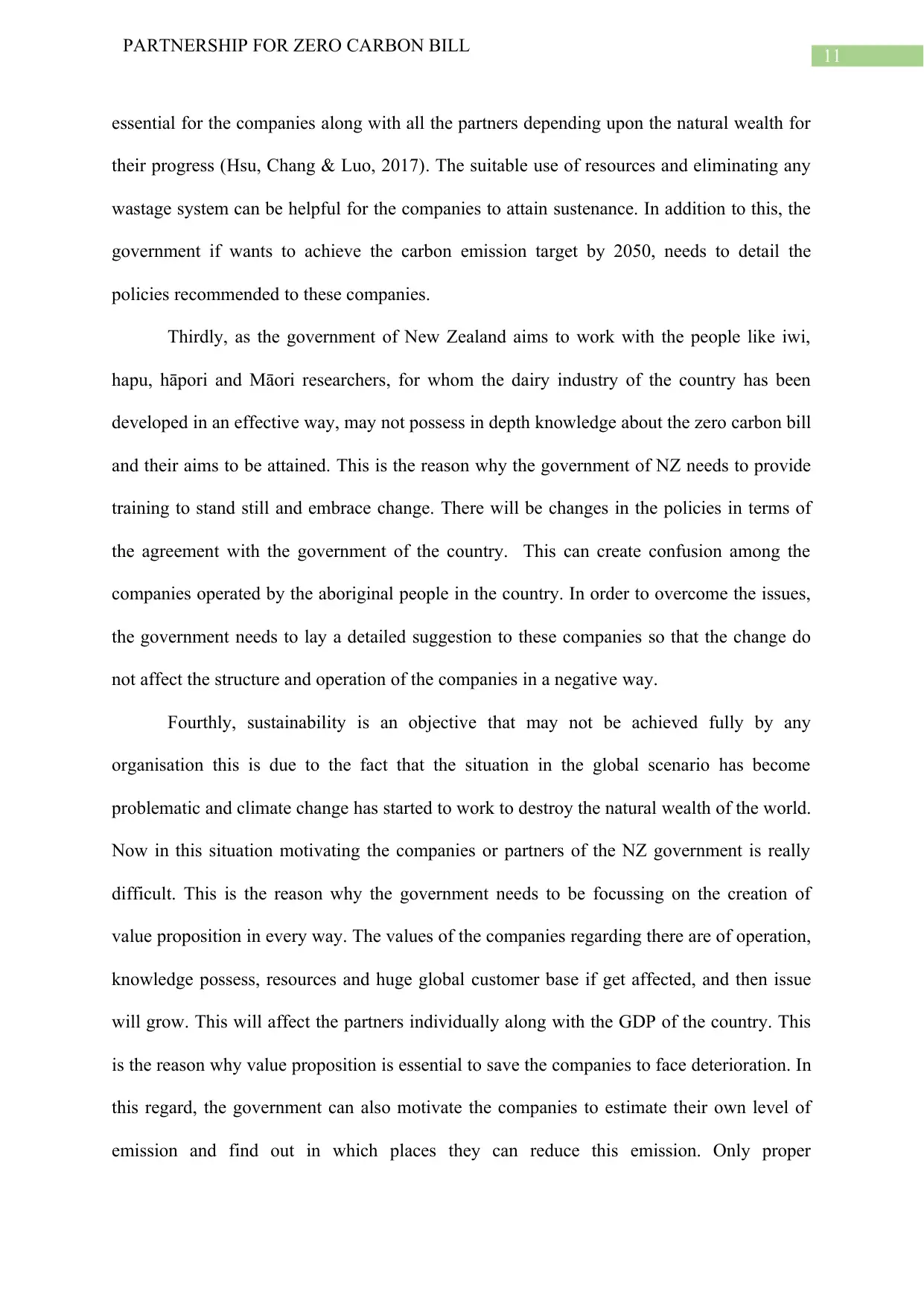
11
PARTNERSHIP FOR ZERO CARBON BILL
essential for the companies along with all the partners depending upon the natural wealth for
their progress (Hsu, Chang & Luo, 2017). The suitable use of resources and eliminating any
wastage system can be helpful for the companies to attain sustenance. In addition to this, the
government if wants to achieve the carbon emission target by 2050, needs to detail the
policies recommended to these companies.
Thirdly, as the government of New Zealand aims to work with the people like iwi,
hapu, hāpori and Māori researchers, for whom the dairy industry of the country has been
developed in an effective way, may not possess in depth knowledge about the zero carbon bill
and their aims to be attained. This is the reason why the government of NZ needs to provide
training to stand still and embrace change. There will be changes in the policies in terms of
the agreement with the government of the country. This can create confusion among the
companies operated by the aboriginal people in the country. In order to overcome the issues,
the government needs to lay a detailed suggestion to these companies so that the change do
not affect the structure and operation of the companies in a negative way.
Fourthly, sustainability is an objective that may not be achieved fully by any
organisation this is due to the fact that the situation in the global scenario has become
problematic and climate change has started to work to destroy the natural wealth of the world.
Now in this situation motivating the companies or partners of the NZ government is really
difficult. This is the reason why the government needs to be focussing on the creation of
value proposition in every way. The values of the companies regarding there are of operation,
knowledge possess, resources and huge global customer base if get affected, and then issue
will grow. This will affect the partners individually along with the GDP of the country. This
is the reason why value proposition is essential to save the companies to face deterioration. In
this regard, the government can also motivate the companies to estimate their own level of
emission and find out in which places they can reduce this emission. Only proper
PARTNERSHIP FOR ZERO CARBON BILL
essential for the companies along with all the partners depending upon the natural wealth for
their progress (Hsu, Chang & Luo, 2017). The suitable use of resources and eliminating any
wastage system can be helpful for the companies to attain sustenance. In addition to this, the
government if wants to achieve the carbon emission target by 2050, needs to detail the
policies recommended to these companies.
Thirdly, as the government of New Zealand aims to work with the people like iwi,
hapu, hāpori and Māori researchers, for whom the dairy industry of the country has been
developed in an effective way, may not possess in depth knowledge about the zero carbon bill
and their aims to be attained. This is the reason why the government of NZ needs to provide
training to stand still and embrace change. There will be changes in the policies in terms of
the agreement with the government of the country. This can create confusion among the
companies operated by the aboriginal people in the country. In order to overcome the issues,
the government needs to lay a detailed suggestion to these companies so that the change do
not affect the structure and operation of the companies in a negative way.
Fourthly, sustainability is an objective that may not be achieved fully by any
organisation this is due to the fact that the situation in the global scenario has become
problematic and climate change has started to work to destroy the natural wealth of the world.
Now in this situation motivating the companies or partners of the NZ government is really
difficult. This is the reason why the government needs to be focussing on the creation of
value proposition in every way. The values of the companies regarding there are of operation,
knowledge possess, resources and huge global customer base if get affected, and then issue
will grow. This will affect the partners individually along with the GDP of the country. This
is the reason why value proposition is essential to save the companies to face deterioration. In
this regard, the government can also motivate the companies to estimate their own level of
emission and find out in which places they can reduce this emission. Only proper
⊘ This is a preview!⊘
Do you want full access?
Subscribe today to unlock all pages.

Trusted by 1+ million students worldwide
1 out of 17
Related Documents
Your All-in-One AI-Powered Toolkit for Academic Success.
+13062052269
info@desklib.com
Available 24*7 on WhatsApp / Email
![[object Object]](/_next/static/media/star-bottom.7253800d.svg)
Unlock your academic potential
Copyright © 2020–2025 A2Z Services. All Rights Reserved. Developed and managed by ZUCOL.




